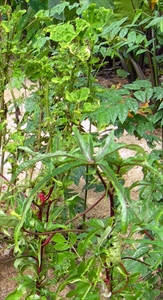- Narrow distribution, Asia and Oceania (but not confirmed). On bele (aibika, sliperi kabis, island cabbage, Abelmoschus manihot), cotton, okra, beans, eggplant, peanut.
- Eggs laid on leaves; nymphs green-yellow, like the adults but wingless; both feed on leaves causing crinkling, yellow patches, sometimes white edges.
- Even small numbers cause damage, perhaps injecting toxic saliva when feeding. Worse in dry times.
- Natural enemies: ladybird beetles, parasitoid wasps, spiders.
- Cultural control: test varieties for resistance.
- Chemical control: PDPs: neem, derris, pyrethrum, or chill; spinosad or Bt (Bacillus thuringiensis); or synthetic pyrethroids, but they will kill natural enemies.
Pacific Pests, Pathogens, Weeds & Pesticides - Online edition
Pacific Pests, Pathogens, Weeds & Pesticides
Bele (Abelmoschus) leafhoppers (039)
Green or Indian cotton jassid (or leafhopper). These are the common names given to Amrasca devastans, but the species in the Pacific has not been identified.
Most likely Amrasca biguttula biguttula; previously, it was known as Amrasca devastans, and Empoasca devastans.
AUTHORS Helen Tsatsia & Grahame Jackson
Information from Bellis G, Fletcher M (2005) Indian cotton leafhopper (Amrasca biguttula biguttula): PaDIL - http://www.padil.gov.au; and from Amrasca biguttula. Wikipedia. (https://en.wikipedia.org/wiki/Amrasca_biguttula). Photo 2 Graham Teakle, Canberra.
Produced with support from the Australian Centre for International Agricultural Research under project PC/2010/090: Strengthening integrated crop management research in the Pacific Islands in support of sustainable intensification of high-value crop production, implemented by the University of Queensland and the Secretariat of the Pacific Community.








